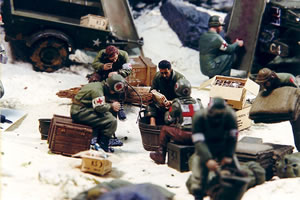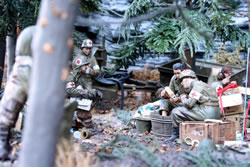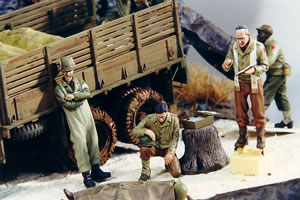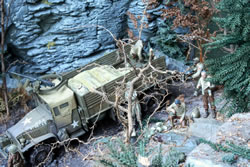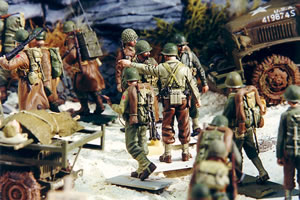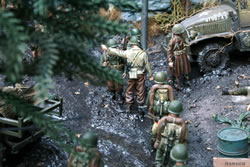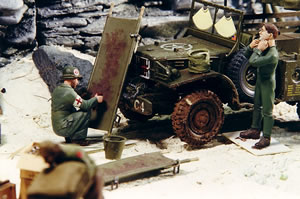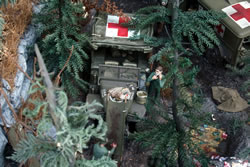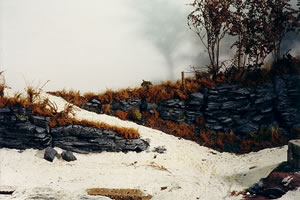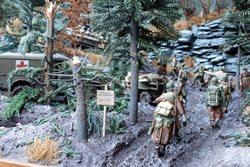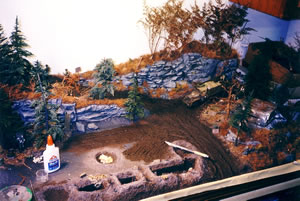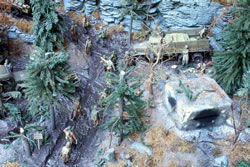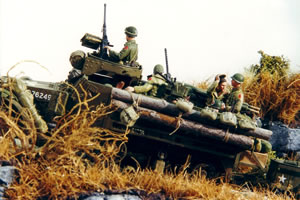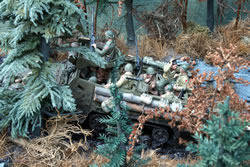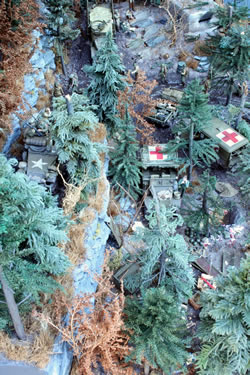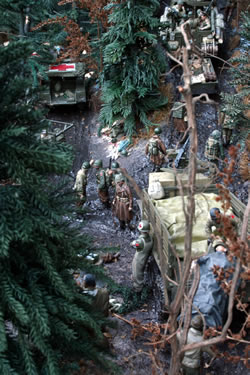| By
the Numbers . . . .
Completed September, 2001
17 months of construction
40"x23" base
53 figures
38 handmade pine trees
18 other
trees
8 vehicles, including 3 trailers
1 pillbox |
This dio
originally was going to be a scene of medics on break but I realized that would
be the same clichéd picture of "soldiers sitting around." So
I expanded it to place them in a more compelling context. To
create the inevitability of this break ending and "business picking up"
again, I added a column of weary Joes slogging through the mud up to the front,
the next round of cannon fodder. To attest to the fact that the medics had been
busy for a long time, I littered the area with stacks of helmets, dozens of empty
supply and rations boxes and mounds of discarded uniforms and equipment. Finally,
to further cement the "story" and complete the circle, I added a deuce
and a half loaded with corpses and a graves registration team picking up the bodies
of those who didn't get saved. To tie the three elements together, I added the
knot of soldiers looking at the lines of tarp-draped bodies waiting to be loaded
onto the truck and the sergeant pointed them forward to the front. Extensive
research was necessary for this project, beyond just reading about the battle
of the forest. Each new idea provoked questions: What was the staffing for an
aid station? What vehicles did they use? What medical equipment did they have?
Who collected the bodies of the dead?
The Setting
The
base of the diorama measures 23" x 42". I needed to create the rough
terrain of the Hürtgen forest, so a good amount of Styrofoam was used to
create different levels, topped off with Celluclay. The rock formation is a model
railroad item, and was painted slate gray as seen in the area. It also underscores
the somberness of the setting and symbolically stands for the German enemy that
stood in the way of these soldiers. The pillbox comes from Verlinden. I
used Hudson and Allen's "Dirt" and "Mud" for the groundwork,
adding acrylic gloss medium for a wet look. The tall weeds came from the tufts
of coarse hemp of a fraying doormat; the were plunged into a puddle of white glue
and "planted" into the damp H&A "Dirt." The trenches and
wheel ruts were filled with "water" made with Envirotex-Lite, a two-part
resin product that was applied in layers. Nearly
40 pine trees were handmade using actual sticks and twigs. I drilled countless
holes into them to attach pine boughs from Hudson & Allen and dried "princess
pine" from a local crafts store. Thoughout
the process, vehicles and figures were positioned and removed to ensure no new
scenic element would interfere with the relationships of the main items. A
lot of research and scratchbuilding went into creating realistic accessories for
the medics. The plasma bottles were made from Tamiya wine bottes, and thin wire
insulation served as tubing, with wire tips for needles. I created the individual
meal K rations boxes with MS Paint and printed them on tan paper. Likewise, I
designed and printed the blue booklets with information tags that were tied to
the wounded soldiers and the many empty bandage boxes that are scattered about.
Dogtags were made from foil, and the small personal effects bags for each of the
dead soldiers were fashioned from epoxy putty. "Between
Life and Death..."
The
Battle of the Hürtgen Forest
Evolution
of the Diorama
M3A1 Halftrack
Dodge
Ambulance and Beep
Willys
Jeep, 2.5 Ton Cargo Truck, Trailers
The Figures
References | 












